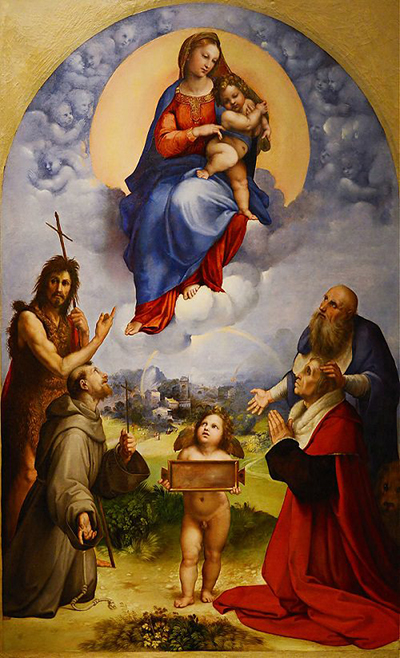The Madonna of Foligno was originally a paint on a wooden piece done in 1511 by Raffaello Sanzio of Uribion, an Italian High Renaissance artist popularly known as Raphael.
This art piece was painted as a request from the First Secretary to Julius II, Sigismondo de’ Conti and was displayed in the Santa Maria church in Aracoeli on one of the high alters. Gismondo Conti was buried in the same church in 1512. In 1565, the granddaughter of Gismondo de’ Conti, Sister Ann Conti, moved the painting to the St. Anne e Antonio monastery in Foligno. It stayed there for almost 200 years, which is how it acquired the name of Madonna of Foligno.
The piece falls into the class of sacra conversazione, which are paintings that include holy figures as subjects having conversations. In this case, it is the Virgin Mary, seated on a bed of clouds with the Baby Jesus in her arms. The two have angels surrounding them like a halo. Below, Sigismondo Conti is on the left kneeling, with his palms brought together in front of him in gratitude and he gazes up to the mother and child. Conti dons in a long red cape, lined with fur. St. Jerome is standing next to Conti, presenting him to the Virgin and Baby Jesus. He has his lion beside him, and his left hand is on Gismondo’s head as if to reaffirm his worthiness to be in the holy presence of Mother and Child.
On the opposite side is St. Francis of Assisi, wearing grey vestments, and kneeling. As he looks at the Baby Jesus, he points to the spectator with his right hand as if to include the world in the blessings they seek. St. John the Baptist is next to St. Francis, dressed in animal skins. He is looking at the spectator while pointing to the Mother and Child as if to draw the viewer in. At the centre of the four men is an angel holding a blank plaque.
The subjects in the Madonna of Foligno have been likened to two artworks by Fra Bartolommeo, The Vision of Saint Bernard and The Vision of Saint Catherine. Bartolommeo's influence on Raphael's work can also be seen in the Sistine Madonna and the Madonna del Granduca. The infusion of out-of-focus angels in clouds is a technique that Raphael used in various paintings of the Roman period. Sigismondo Conti commissioned the Madonna of Foligno as thanksgiving for having been spared during a disaster, which is why the towers of Foligno are included in the background.




